I spent nearly three months exploring Vietnam over two trips, doing most of the classic Saigon to Hanoi itinerary twice in that time as well as exploring the Mekong Delta and the islands in depth. I´ve been helping friends and family build their Vietnam itineraries for the past few years and figured it was time to finally share my recommendations here on the blog as well.
This is a very long post with lots of places, so I´ve cut the itinerary into three parts: The “classic” 3 Week Vietnam Itinerary from Saigon (Ho Chi Minh City) to Hanoi; The Southern Loop around the Mekong Delta and the islands of Phu Quoc and Con Dao; and the Northern Bucket List Destinations with the Phong Nha caves, trekking in Sa Pa and boat tours around Halong Bay.
You can use these three itineraries, along with the suggested routes and times for each place, to build your custom itinerary, whether you are spending 2 or 3 weeks in Vietnam or several months. I´ve also included some practical information on visas, accommodation and getting around at the end.
Here´s what we´ll cover:
Contents
3 week Vietnam Itinerary: Saigon to Hanoi
The Classic tour that I’ve put together takes you from Saigon to Hanoi, hitting all the famous spots on the way. This can be done in as little as 2 weeks thanks to the train connection running all the way from Saigon to Hanoi, but if you can, ideally, this is a 3 week Vietnam itinerary.
The Reunification Express train line stops in Saigon, Phan Tiet (for Mui Ne), Nha Trang, Da Nang, Hué and Hanoi, making this an ideal trip for individual travelers who prefer not to be on organized tours. Traveling by train is also a great way to see the country and avoids a lot of the hassle that flying brings with it these days.
Here is a sample itinerary:
3 Week Vietnam Itinerary: Saigon to Hanoi
Day 1 -3: Saigon for incredible food and to learn about Vietnam’s history
Day 4-6: Mui Ne for sand dunes, easy hiking and a beach break
Day 7-8: Nha Trang for city night life and mud baths
Day 9-11: Da Lat for mountain air and guided Easy Rider motorbike tours
Day 12-14: Hoi An to explore the UNESCO World Heritage old town and get tailored clothes
Day 15: Da Nang for stunning views from Hai Van Mountain Pass
Day 16-17: Hué, Vietnam’s former capital for a visit to the historic imperial city and tours of the DMZ
Day 18-21: Hanoi to stroll around the old town exploring history and architecture, and sipping on egg coffee
Saigon (Ho Chi Minh City)
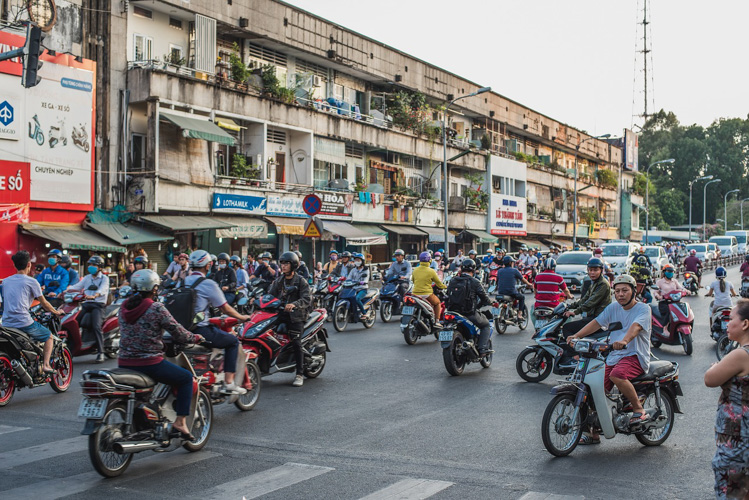
Hanoi may be the capital, but Saigon, aka Ho Chi Minh City, is the foodie and cultural hub of Vietnam. Fly into HCMC airport, and get yourself a hotel or guesthouse right in the center of the city in District 1 to soak up the atmosphere of this bustling, slightly crazy city.
The area around Ben Thanh Market and Bui Vien street is quite touristy, but will make your first couple of days in Vietnam easy. Plus you will be surrounded by great street food – which is what Saigon is all about. In the evenings, go to one of the many places that serve Bia Hoi, fresh brewed beer, and sit outside on the street on tiny plastic chairs watching the world go by. If you’ve had too much to eat already, check out the War Remnants Museum or go for a day trip to the Chu Chi Tunnels to learn about the Vietnam War (although the tunnels near Hué, if you’re planning a DMC tour, are more impressive).
Check out my post on Saigon food for tips on what to eat in this amazing city.
Mui Ne
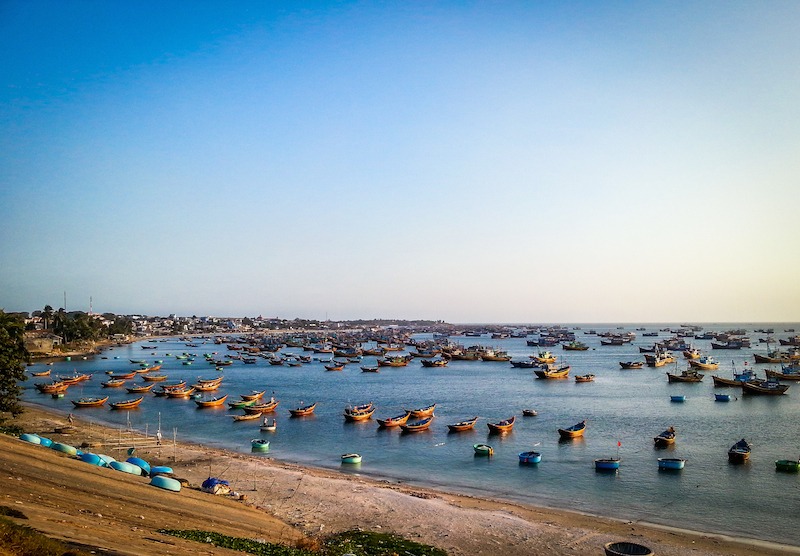
Get away from the hustle and bustle of the city and catch an early morning train to Phan Thiet, then grab a taxi from there to Mui Ne, a long stretched coastal village that has turned into a popular but laid back beach destination just a few hours from Saigon.
Mui Ne is famous for its red hued sand dunes and its “fairy stream” creek which makes for a great, easy morning or late afternoon hike – you can walk directly in the river bed, as the water tends to be very shallow in most places.
If you’re a kite surfer, Mui Ne is a great place to practice your sport. For the rest of us, it’s a great place to take sunset photos that will make everyone at home jealous. And with Mui Ne village itself being a traditional fishing village, there’s great seafood and generally great food to be had.
Nha Trang
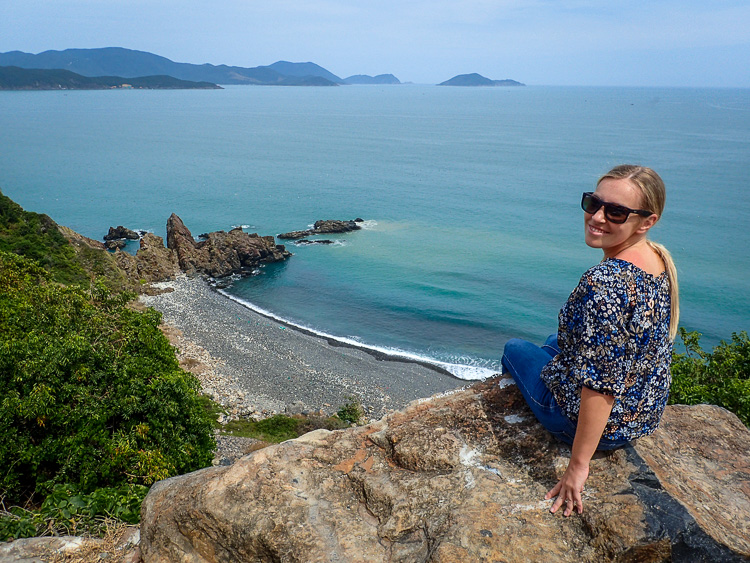
Continue along the Reunification Express train line to Nha Trang. This city is one of Vietnam’s most famous beach destinations, as well as the country’s party capital. It attracts tourists from all over the world. If late night parties are your thing, you’ll probably love it.
If you’re not much of a party person, you may prefer to stay in one of the hotels at the outskirts of the city, and take a day trip down to Cam Ranh Bay, which boasts some of the most beautiful beaches in the country, or spend the day at one of the mud bath spas Nha Trang is also famous for.
Da Lat
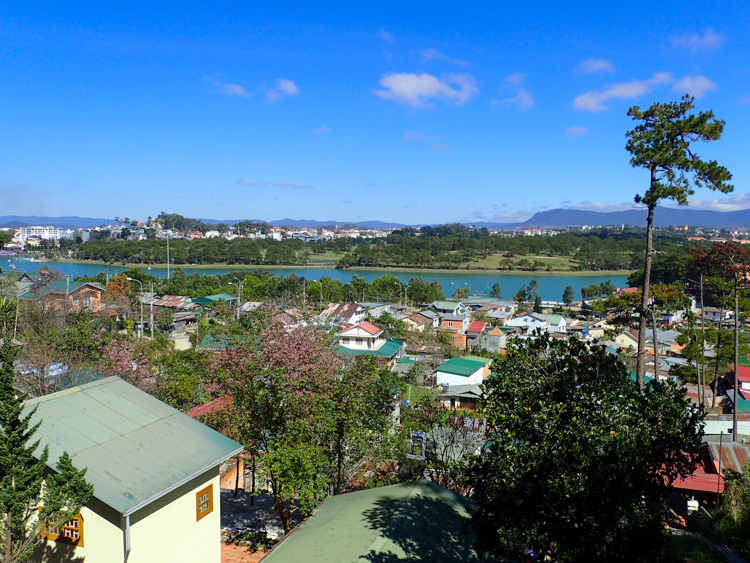
Moving away from the coast and into Vietnam’s Central Highlands, drive or take a bus up to Da Lat, known as the Switzerland of Vietnam. This place feels more European than Vietnamese in many respects, although with an eclectic mix: the lake in the middle of town feels like you’re in the Alps, the colonial French architecture and the replica of the Eiffel tower make you think you’re in France, whilst the “Crazy House” reminded me of the Gaudi architecture I see all over Barcelona.
My recommendation for Da Lat is to combine a visit to this town with one of the famous Easy Rider motorbike tours, either from Nha Trang to Da Lat or from Da Lat to Hoi An. We did a seven day tour from Da Lat all the way to Hué and it was one of the best things we’ve ever done on our travels, and a great insight into Vietnamese life and culture.
Hoi An
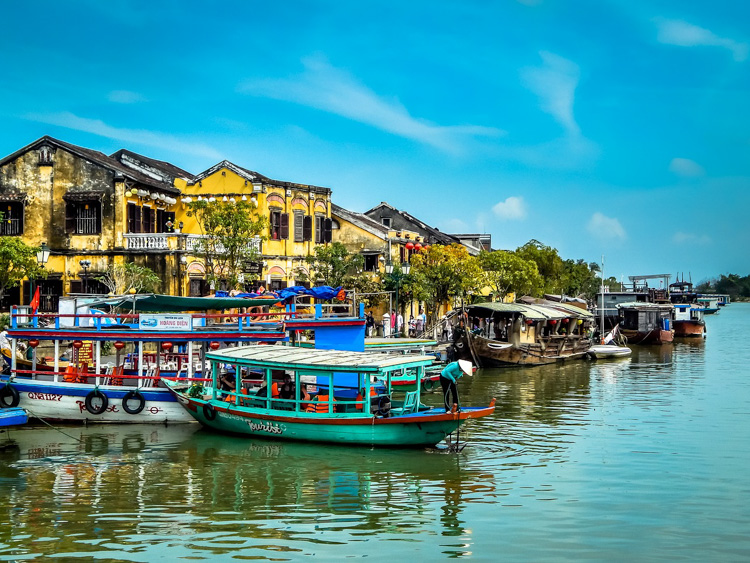
From Da Lat, drive back to the coastal area to Hoi An. The city’s historic center is a UNESCO World Heritage site, with beautiful protected buildings from its era as a major trading port. Take a stroll along the river and through the old town at night when it’s lit up with thousands of lanterns.
Hoi An is also famous for its many tailors, so if you’re looking for new clothes, consider a few extra days in Hoi An to get a new wardrobe tailormade. You’ll find most tailors around the market in the old town, which is also a great lunch spot to try the city’s famous noodle dish Cao Lau.
While Hoi An is mainly worth visiting for its city center, there are also beautiful beaches nearby if you need a day off from sightseeing (An Bang is my personal favourite), and the Cham ruins of My Son make for a great day trip.
Da Nang
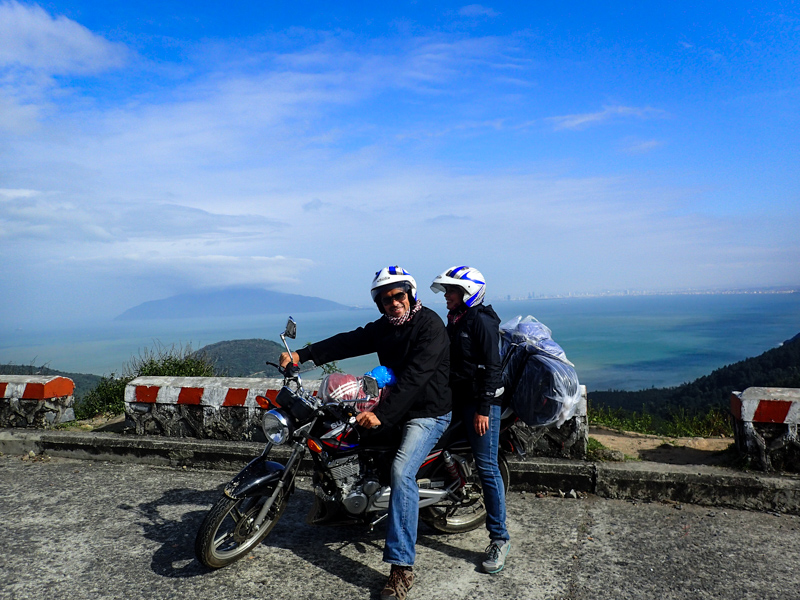
Just a 20 minute drive away from Hoi An is Da Nang, a major port city on the South China Sea. If you’ve been staying in Hoi An, you can just spend a day in Da Nang visiting the Marble Mountains and the Dragon Bridge (best viewed in the evening when the lights are on).
If you have more time, take a day to drive up the Hai Van Pass for stunning ocean views. You can also do this as part of a motorbike tour, or rent your own scooter.
Hué
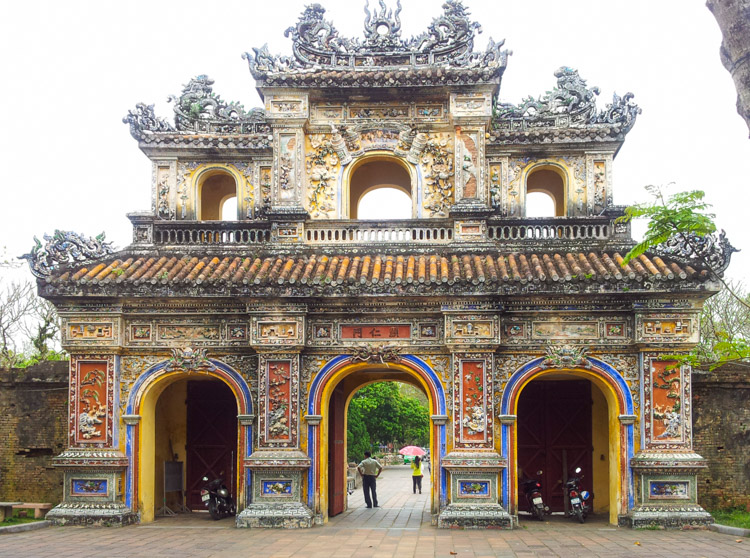
Take the train from Da Nang to Hué, Vietnam’s former capital and a city full of history. Visit the old Imperial City, take a ride on a dragon boat along the Perfume river, and indulge on the famous Bun Bo Hué soup.
Hué is also a great base for a day tour of the DMZ, the demilitarized zone dividing North and South Vietnam after the First Indochina War and an important battleground area during the Vietnam War. Khe San Combat Base and the Vinh Moc tunnels are well preserved and should be on your list if you’re looking for a tour.
Hanoi
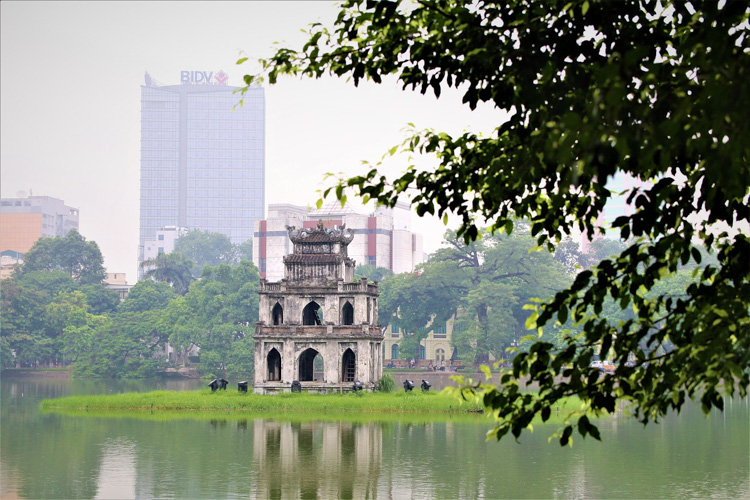
Hué to Hanoi is a longer stretch, but can be done by train if you’re up for a 14 hour journey (night trains with lie flat beds and newly refurbished – in some cases brand new – cars are available). Hué also has an airport though, and it’s a quick flight up to Hanoi if time is short.
Hanoi is Vietnam’s capital and very different to Saigon. It’s less hectic, much more traditional, and full of history. Stroll around the old town, walk around Hoan Kiem Lake and go for an egg coffee at Giang Café.
Hanoi’s culinary scene is a highlight itself. The famous Pho noodle soup is a Hanoi staple, another popular dish worth trying is Bun Cha, grilled pork with rice noodles and lots of herbs.
Southern Vietnam: Mekong Delta Itinerary
The Mekong Delta can be a multi week trip in itself, or you can choose a couple of places to tag on to a larger Vietnam trip. Whilst most people go to the Mekong Delta from Saigon on an organized tour, with a bit of a sense for adventure you can easily do the Mekong Delta without a tour.
It´s a great destination to explore the slower side of Vietnam, especially for foodies – the Mekong Delta is often called the “rice bowl of Vietnam”, and travelers will find an abundance of fresh tropical fruit and seafood, brought into cities and villages by boat on the Mekong and its many canals.
Create your itinerary using the destination suggestions below based on how much time you have to explore and whether you are looking more for active adventure or lazing on a beach for a few days. Most travelers just dip into the Mekong Delta for a couple of days, but if you have time to explore the area in depth, here is a suggested 2-3 week Southern Vietnam itinerary (add or subtract days on the islands as needed to fit your schedule):
Sample itinerary Southern Vietnam: Mekong Delta and Islands
Day 1-4: Con Dao for a relaxed beach vacation or diving
Day 5-6 (half day): Can Tho with a morning visit to Cai Rang floating market
Day 6:-7: Rach Gia for a local, inexpensive foodie experience
Day 8-12: Phu Quoc for more beach time and lots of sea food
Day 13-15: Vinh Long / An Binh for bicycle tours and boat trips on the Mekong
Day 16-17: Ben Tre for exploring the Mekong islands on scooter and eating coconut candy
Day 18: Back to Saigon for onward travel.
Can Tho
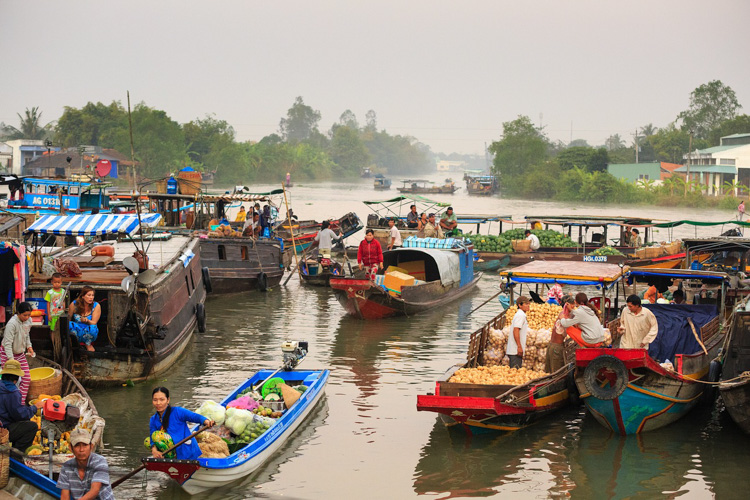
Can Tho is the main city in the Mekong Delta and a major travel hub. It has its own airport, which can be great to reach the Southern islands from, often at a considerably cheaper price than from Saigon.
Can Tho somewhat of a commercial capital for the Mekong Delta, and a great base for travelers who enjoy a buzzing city life with plenty of cafés and restaurants. The nearby floating markets on the river and canals surrounding the city, where trade is done on the water from boats, attract travelers from all over the world.
Cai Rang Floating Market is probably the Mekong Delta´s most famous market and can get busy, but is worth checking out. The larger boats sell fruit, vegetables and other goods for wholesale, but there are also many small boats that sell cooked breakfasts on the spot. If you are looking for a more slow-paced local market, consider exploring Phong Dien Floating Market.
In the evening, snack on the street food at the local night market or on the main foodie street, De Tham Street. Dishes to try are “Hu Tieu”, a noodle soup typically made with pork broth, and Bun Rieu, tomato and crab soup. Afterwards, head to the city´s “beach” on the Mekong river for drinks and people watching.
Ben Tre
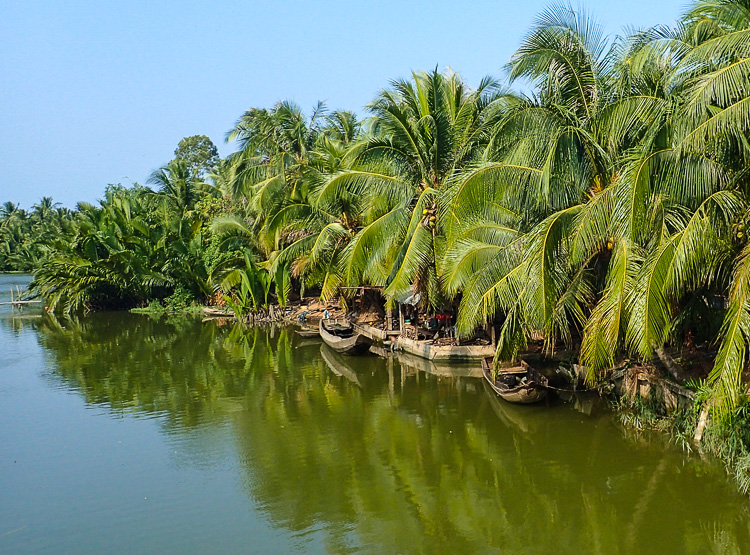
Ben Tre was my personal favourite in the Mekong Delta. It´s too far from Saigon to attract the many day tour groups, slower paced than Can Tho, and attracts very little tourism compared to most larger towns in the area.
The river front is quiet most of the time, the night market is geared towards locals, and finding great food can be a challenge, but once you find it, is absolutely worth it. Ben Tre is surrounded by palm trees and coconuts are everywhere. The town is famous for its coconut candy, keo dua, so a visit to a candy factory is a must. This is also where we found the best coconut smoothies in all of Vietnam.
Ben Tre is an awesome base for motorbike or bicycle tours. We chose to rent a scooter from our hotel and spent our days getting lost on tiny roads (if you can even call them that) on the many islands in the Mekong just outside of town, purposely getting lost and finding ourselves at the literal end of the road, making it from one island to the next on questionably looking tiny wooden ferries.
I wrote extensively about how to explore Ben Tre without a tour, the post is worth a read before you go to guide you on the local food experiences, as they can be hard to find on your own.
An Binh / Vinh Long
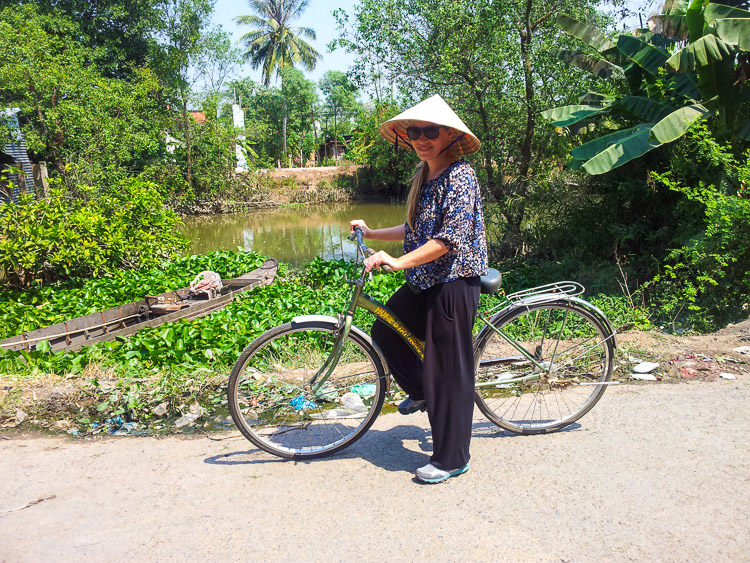
If Ben Tre sounds too adventurous to you but you want to explore a provincial town on the Mekong on your own, the town of Vinh Long and the nearby island of An Binh might be just what you are looking for.
An Binh is a sleepy island in the Mekong that is virtually car free, as most roads are so narrow they can only be navigated by scooter or bicycle. You can stay directly on the island at one of the many homestays that have opened up over the years, catering to independent travelers and offering everything from organized day tours in small groups and bicycles for rent to family style dinners. They are typically set up more like guest houses or hostels, so don´t expect to be the only traveler there.
We spent our days in An Binh exploring the island on bicycle, lazing in one of the hammocks in our homestay´s lush tropical garden, and taking the ferry into town for lunch at the local market, a refreshingly authentic place with few tourists and plenty of local fare. We also had our homestay organize a day trip for us, where a boat took a group of 8 travelers to nearby Cai Be floating market, to a candy factory (with plenty of candy sampling!) and into mangrove forests.
Check out my post on An Binh and Vinh Long for more info.
Rach Gia
Rach Gia is a harbor city on the Gulf of Thailand and similarly to Can Tho, a transit city with the main destinations being the Southern islands of Vietnam (Phu Quoc and the Nam Du archipelago) and nearby Cambodia´s Kep.
It doesn´t have a ton of attractions, but is worth spending a day to explore the local food scene if you have time before traveling onwards. It is not geared to tourists the way some of Vietnam´s “highlights” like Hoi An are, but we found the locals and our hotel incredibly helpful and friendly.
Staying at one of the hotels right by the harbor makes it easy to catch the ferry early in the morning, and you will find plenty of food stalls offering breakfast as early as 5am. Our hotel, at an incredible rate of 11 euros for a night, provided us with a cell phone for the duration of our stay and a free chauffeur service to a restaurant at night.
The Southern Islands in Vietnam
Vietnam is not as well known for island escapes as nearby Thailand, but the country has a number of lush tropical islands with stunning beaches (check out my post on the best beaches in Vietnam) where you can still find yourself alone on a deserted beach with no crowds and no beach vendors, making for a great relaxing break.
Phu Quoc
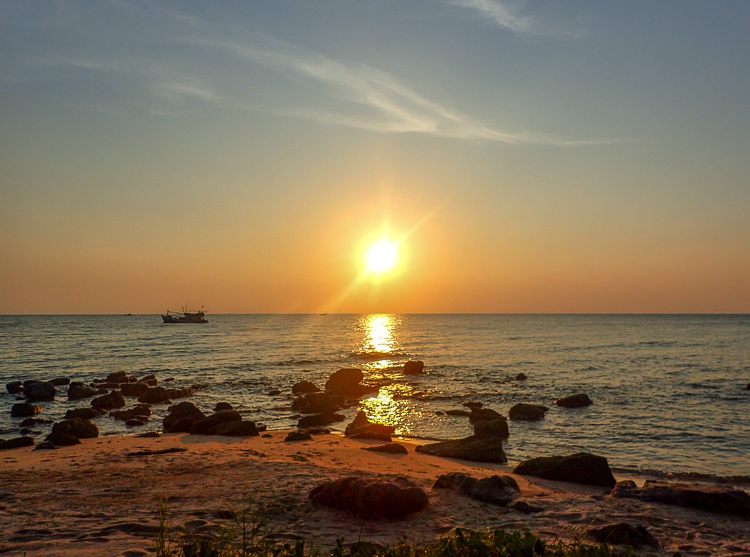
Phu Quoc is easily reached by plane from any of the country´s major airports and by ferry from Rach Gia or Ha Tien (on the Cambodian border). It is Vietnam´s most well known island and in some areas a bit overrun with tourists in high season, but even on Phu Quoc you will find deserted beaches if you dare to venture out on a scooter to explore the island. The time to go is now, before more tourist resorts open up and turn the island into a massive tourist magnet.
On the Western coast of Phu Quoc, Ong Lang beach offers stunning sunsets with less crowds than nearby Long Beach on the island´s main town, Duong Dong. We found the town center to be incredibly touristy, but the area around the day market on the edge of the river was a bit sleepier, with food stalls offering great take-away dishes to make yourself a beach picnic with fresh spring rolls and baked goods.
The Eastern coast is still relatively quiet, and we spent a week at Kiki Coconut beach in a three bungalow homestay resort surrounded by nothing but palm trees and water, having family style dinners with the owners and the other guests every night.
Sao Beach is a stunning postcard perfect white sand beach with shallow water and a line of palm trees offering shade in the topical heat, although trash on the beach can be an issue, especially after storms.
Nam Du Archipelago
Nam Du is on my bucket list, but sadly during our trips to Vietnam was extremely hard to reach and secure accommodation on. It has only recently opened up to foreign tourists, and tourism infrastructure on the islands is still in its infancy, making it all the more attractive to travelers looking to escape from the busier areas of Vietnam.
Nam Du is a small archipelago of rocky fisherman islands, with small white sand bays and turquoise water surrounding the islands. Vietnam Coracle has a great guide to Nam Du.
Con Dao
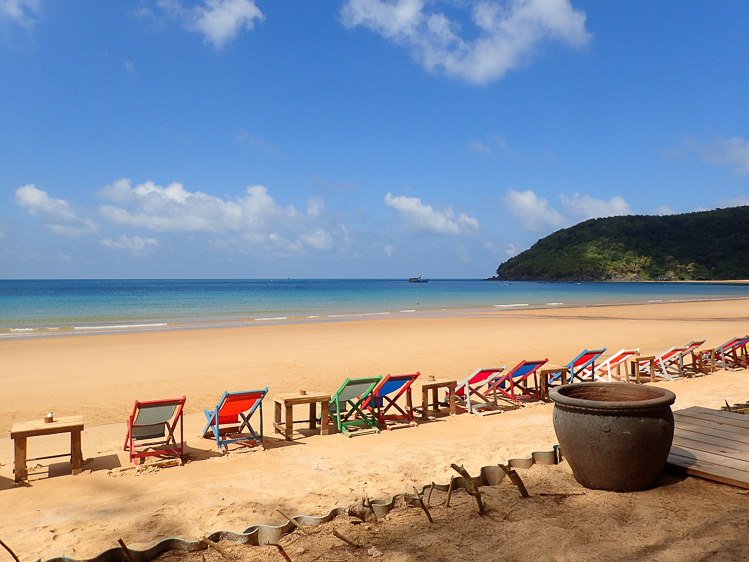
Con Dao archipelago is one of my favourite places in Vietnam. It has a dark past, with French colonialists using the main island of Con Son as prison island. Con Dao is a pilgrimage destination for Vietnamese travelers coming here to pay respects to the people who died in the prisons.
Much of the archipelago is a National Park today and therefore protected from the rapid development happening in other areas of the country. Most beaches are still untouched or just have a couple of wooden shacks at the treeline on the edge of the tropical jungle offering drinks and all-day food, served to you in your hammock or wooden sun lounger. We rarely shared the beach with more than 10 people.
Con Son is a quiet town with a slow paced market, a few restaurants and small guest houses. There are a few beach resorts, from basic hostel-style bungalow resorts to the luxurious Six Senses Resort with private pool villas. Unless you want to splurge on the Six Senses, we found the guest houses in town to be a better base to explore the island as the better beaches are quite isolated and you´ll want to visit them all.
While there are a couple of taxis on the island, the best way to get around is a scooter. The roads are mostly deserted, there is barely any traffic and we occasionally found ourselves going down tiny narrow sand paths to get to our destinations.
My personal highlight was Dam Trau Beach, aka airport beach, a sandy beach surrounded by rocky jungle set just behind the island´s airport landing strip, with small propeller planes flying right over your head a few times per day. It boasts a few wooden shack bars that feed you with local dishes and fresh coconuts all day long so you never have to leave.
Con Dao is best reached by plane, as ferries are highly dependent on weather, take a long time and there are just way too many stories out there about people getting sea sick on this route. Most people fly in from Saigon, but we found flights to and from Can Tho to be considerably cheaper. We flew in from Saigon and out to Can Tho, combining our visit to Con Dao with our Mekong Delta trip.
The Northern Vietnam bucket list Destinations
Halong Bay
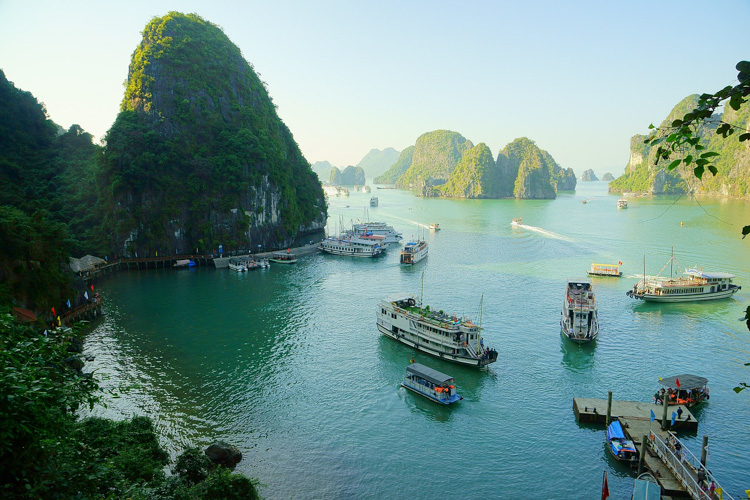
Halong Bay is a group of thousands of small limestone islands, surrounded by Emerald Green water. It´s a UNESCO World Heritage site and popular for boat tours and multi-day cruises on traditional junk boats.
It can get incredibly busy, so choose your time to go and the boat tour well. The weather can also be a bit of a downer in the winter months, so this is more of a destination for warmer months, if you want to explore it in T-Shirt and flip flops.
Sa Pa
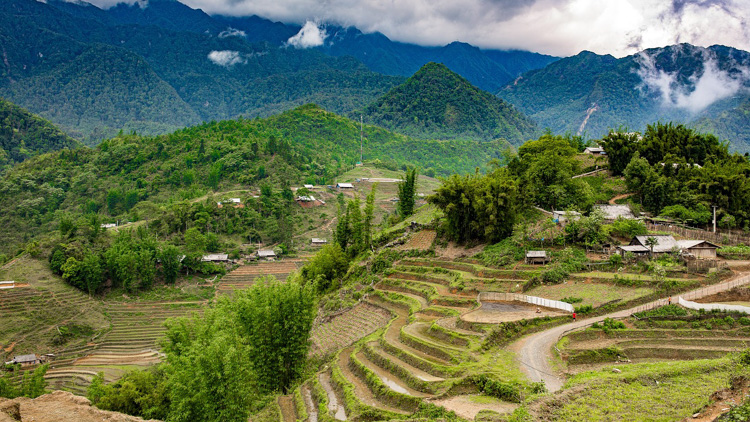
Sa Pa is a mountain city easy to get to by train, famous as a trekking base for visits to the many hill tribe villages nearby. The area is lush and green, with terrace rice fields everywhere. The Vietnamese railway offers overnight trips to Sa Pa via nearby Lao Cai from Hanoi, an easy and comfortable trip in air-conditioned sleeper cars with stunning scenery on the way.
This is one of the areas with the most tourism development in the last decade; so if you are looking for a quiet local experience, consider visiting the Central Highlands near Da Lat instead.
Phong Nha
Phong Nha National Park is an adventure traveler´s paradise, with massive limestone cave systems that even feature underground rivers. The area’s highlight is Son Doong Cave, the largest cave in the world with some areas inside it being 200m high and 150m wide.
Above ground, the dense forests are popular for trekking, kayaking and mountain bike tours with wildlife spotting.
Practical tips for your Vietnam trip
Visas
As of 2019, EU nationals can visit Vietnam without a visa for a maximum of 15 days. For longer trips up to 30 days, you can request an electronic visa in advance of your trip on the government website.
Another option for longer trips and if your nationality is not eligible for the visa on arrival or electronic visa, is the Vietnam visa on arrival. You can request your visa to be arranged by a travel agency or by your hotel, who will provide you with a letter that you bring to the airport and exchange for a visa on site. Be aware that this option is only available if you arrive by plane at one of the country´s international airports, so check in advance to make sure you are eligible.
The last option is a pre-arranged visa that you can get from a Vietnamese embassy before your trip. This option is a guaranteed way to get into the country via any airport or land border crossing and your best option if you are on a slow trip around South East Asia and crossing into Vietnam from Cambodia, for example.
See my posts on getting a Vietnam visa on arrival and on how to get a visa at the Vietnamese embassy in Sihanoukville, Cambodia for more info.
Accommodation in Vietnam
Most towns and cities in Vietnam have very affordable, clean hotels and guest houses with private double rooms with bathrooms. Rooms range from 10-15 dollars a day for basic hotels in more rural areas like the Mekong Delta and Da Lat to about 30-50 dollars a night for nice but basic boutique hotels in the major cities like Saigon, Hoi An and Hanoi. On the higher end of the market, you can find beautiful resorts along the coast and on the islands with prices reaching up to 1,000 dollars a night – you can absolutely splurge if you want to, but it isn´t necessary and we stayed at many hotels and homestays with pools, delicious local breakfasts and great service in the 20-40 dollar range.
Getting Around in Vietnam
For the classic itinerary of Vietnam, the Reunification Express train line is a great way to get from city to city. Trains are mostly comfortable, and sleeper trains have recently been upgraded and renovated. Check out my post on the Reunification Express trains for more info and photos.
The Mekong Delta and Da Lat are most easily reached by bus or minibus. We have found that spending a bit more on a “luxury bus” or “VIP bus” can be worth the money, as roads can be full of pot holes and you´ll appreciate being on a bus with proper suspension for longer trips.
Most hotels will be happy to book bus tickets for you and know the local routes. If you find yourself without hotel support, travel agencies are usually on every corner in the more touristy areas of the country and will arrange tickets. That being said, we have also in numerous occasions just walked up to the bus station and asked for same day or next day tickets on site. The advantage here is that you can usually see what bus you´ll be on, ensuring you get what you are looking for.
Be aware that for more remote destinations, busses will sometimes drop you off at a highway intersection rather than in town. Motorbike taxis will take you to where you need to go, and in the one instance where we needed a car taxi and there was none to be found, a motorbike taxi driver ended up calling a taxi for us – we´ve never ended up completely stranded.

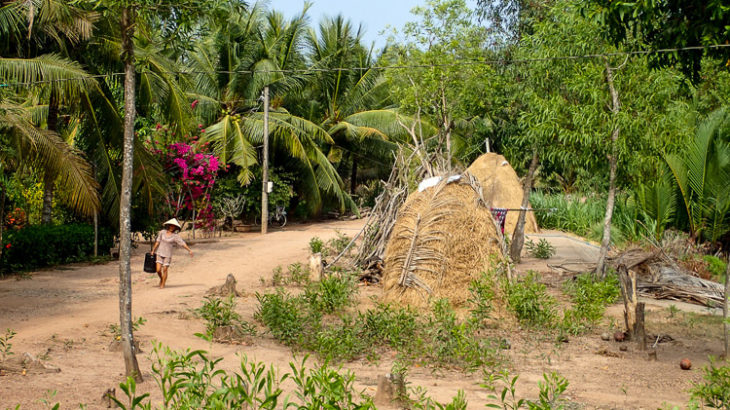
 English
English Deutsch
Deutsch